Nathan Adrian Ready for Racing Return After Testicular Cancer Battle
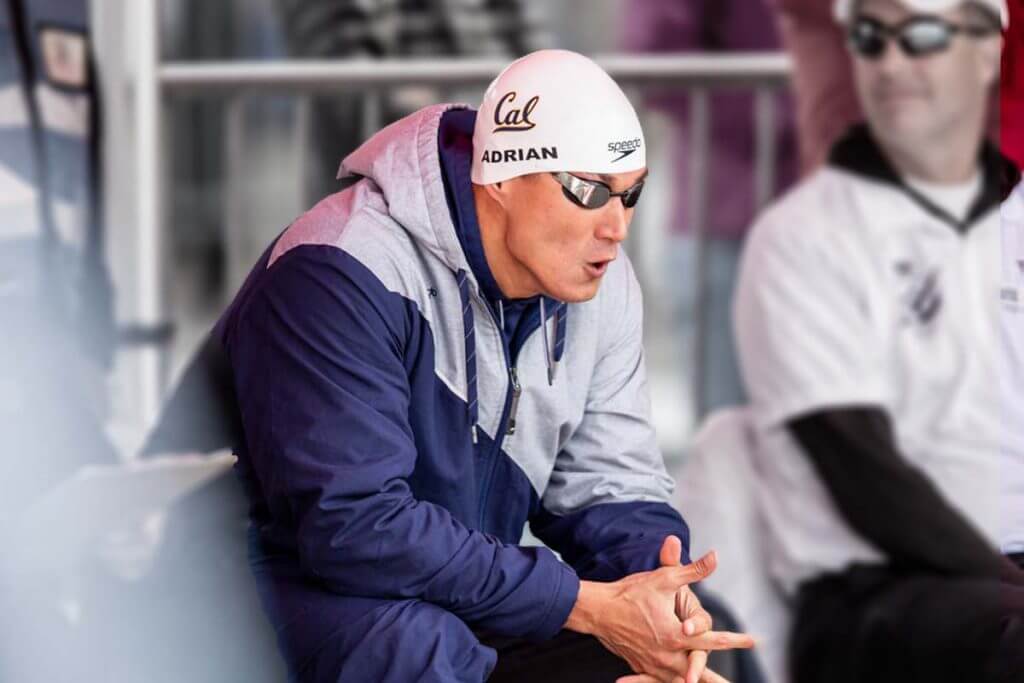
Becoming an elite athlete requires focus and dedication to a systematic training plan. Everything gets mapped out, from the timing and duration of exercises to what foods will best prepare the human body for peak performance. Nathan Adrian has lived by that mantra for a decade—but five months ago, he received news that threw his entire life for a curve.
Adrian’s dedication helped him become the sprint freestyle rock for the United States, and he has remained in that role since 2009—until this past December, when some pain and swelling sent him to his doctor, who in turn sent Adrian for an ultrasound. Days later, Adrian received the news that made any training plans trivial by comparison.
He had cancer, specifically testicular cancer. And naturally, when he heard that dreaded c-word, he thought the worst.
“You get a diagnosis of cancer, and the immediate thing is obviously thinking death,” Adrian said. “There’s no doubt about it. I don’t want to sugarcoat that. I would be doing a disservice to anybody reading this article that may in the future get that diagnosis to pretend like I ignored that.”
Sure, the odds were slim that testicular cancer would prove fatal for an otherwise-healthy, 30-year-old Olympic swimmer still at the top of his game. But that trying month forced Adrian to think (a lot) and to evaluate his life on a broader scale. And despite the ever-present support from those closest to him, to feel helplessly alone.
Surgeries and the Aftermath
Weeks after he first noticed the lump labeled “cancer until proven otherwise,” doctors performed an orchiectomy, removing Adrian’s infected testicle. And then he waited—and waited. Following that surgery, a pathology report typically arrives within seven to 10 days. Instead, the Christmas and New Year’s holidays delayed that.
Finally, a CT scan that could have proven Adrian cancer-free showed evidence of possible trouble in lymph nodes. Doctors gave Adrian options: go on active surveillance and hope the situation doesn’t deteriorate, begin preventative chemotherapy or more surgery. Adrian chose the third option: a non-invasive laparoscopic RNLND surgery conducted with the aid of a Da Vinci robot.
That night, Adrian got up to walk, but he barely made it halfway down the hall before getting winded. He went home the next day—compared to the average two-or-three-day hospital stay following that surgery—but he wasn’t out of the woods yet.
“My body was bloated and feeling terrible,” Adrian said. “I couldn’t lift more than like 10 or 15 pounds for three or four weeks after surgery because we wanted to reduce the risk of a hernia. I had to be on this horrible, nonfat diet because when you eat a lot of fat, it stimulates the lymphatic flow, and when they remove lymph nodes, there’s going to be an empty lymph channel that they clip off.”
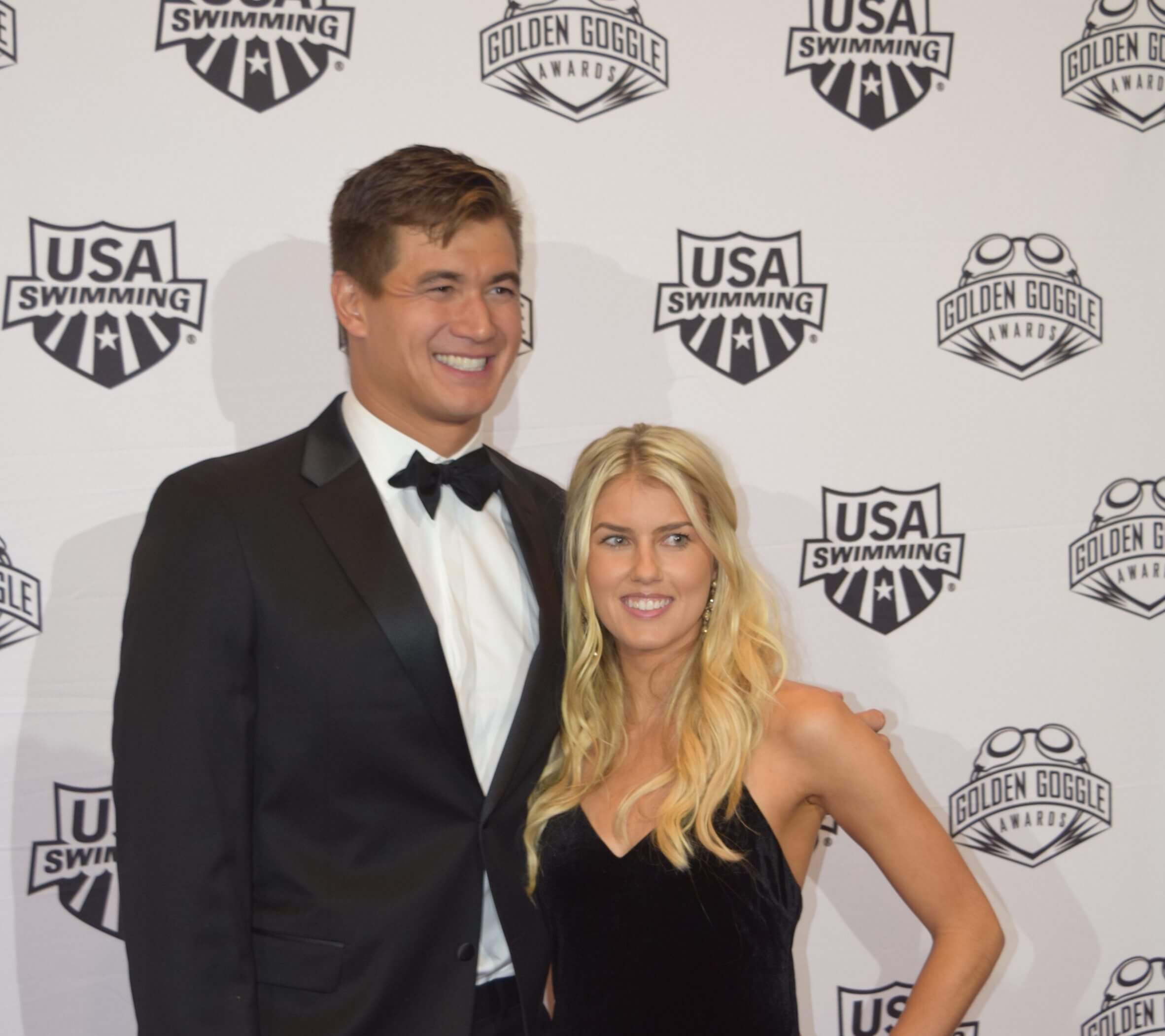
Adrian and his wife, Hallie — Photo Courtesy: Annie Grevers
Adrian had never struggled to adhere to a diet before, but a limit of 20 grams of fat per day—“That’s like a tablespoon of olive oil,” he said—meant that he was never satiated. He remembers finishing meals, still feeling hungry and “twiddling my thumbs.”
During that entire stretch, Adrian felt completely cut off from his normal routine. A professional swimmer for eight years, the routine has hardly changed: go to swim practice and dryland, work on recovery, handle sponsorship obligations and side projects. Now, all of that stopped so he could try to get himself healthy.
Adrian’s wife, Hallie, was with him through the entire process, and his mother, Cecilia, and his father, James, visited at different points. Adrian also credited his in-laws and even his Cal teammates and coach, Dave Durden, for helping support him. Still, Adrian spent plenty of long hours idle by himself. And when humans are idle, they think—too much.
“You think the worst. Maybe I am done swimming, and we have to work on finding another career after this,” Adrian said. “Maybe we have to do chemotherapy. That definitely is going to put a huge damper on this summer. That might still affect me next summer. Where we have aspirations of being on the podium as an individual, you’re going to have to taper those back if you go through chemo, something that is literally poisoning your body for three or four months.”
What if the months dragged on and Adrian was still getting winded going up stairs? What if he did have to undergo chemotherapy and that affected his future ability to have kids?
“There were ups, and there were downs,” he said. “There were tears and very, very sleepless nights. All of the above. I don’t think I do it justice, really narrating my own story. Honestly, it’s really, really exhausting to relive. It’s hard, man. It was a really hard time.”
Adrian’s Chlorinated Medicine
“I think there’s certain moments in your life that you’re always going to remember forever,” Adrian said. For Adrian, one of those came when he told Durden that he had cancer, shortly after his initial diagnosis, but before the orchiectomy.
“I purposely went to practice early that day and just walked in his office hoping I would catch him. I walked in, closed the door and said, ‘Hey, man. I’ve got something to tell you.’ Told him, and he was super supportive, as he is with pretty much everything. His first question is always—whether or not it’s cancer or a young athlete coming to him and telling him any sort of news—‘What can I do to help, and what can I do to support you?’”
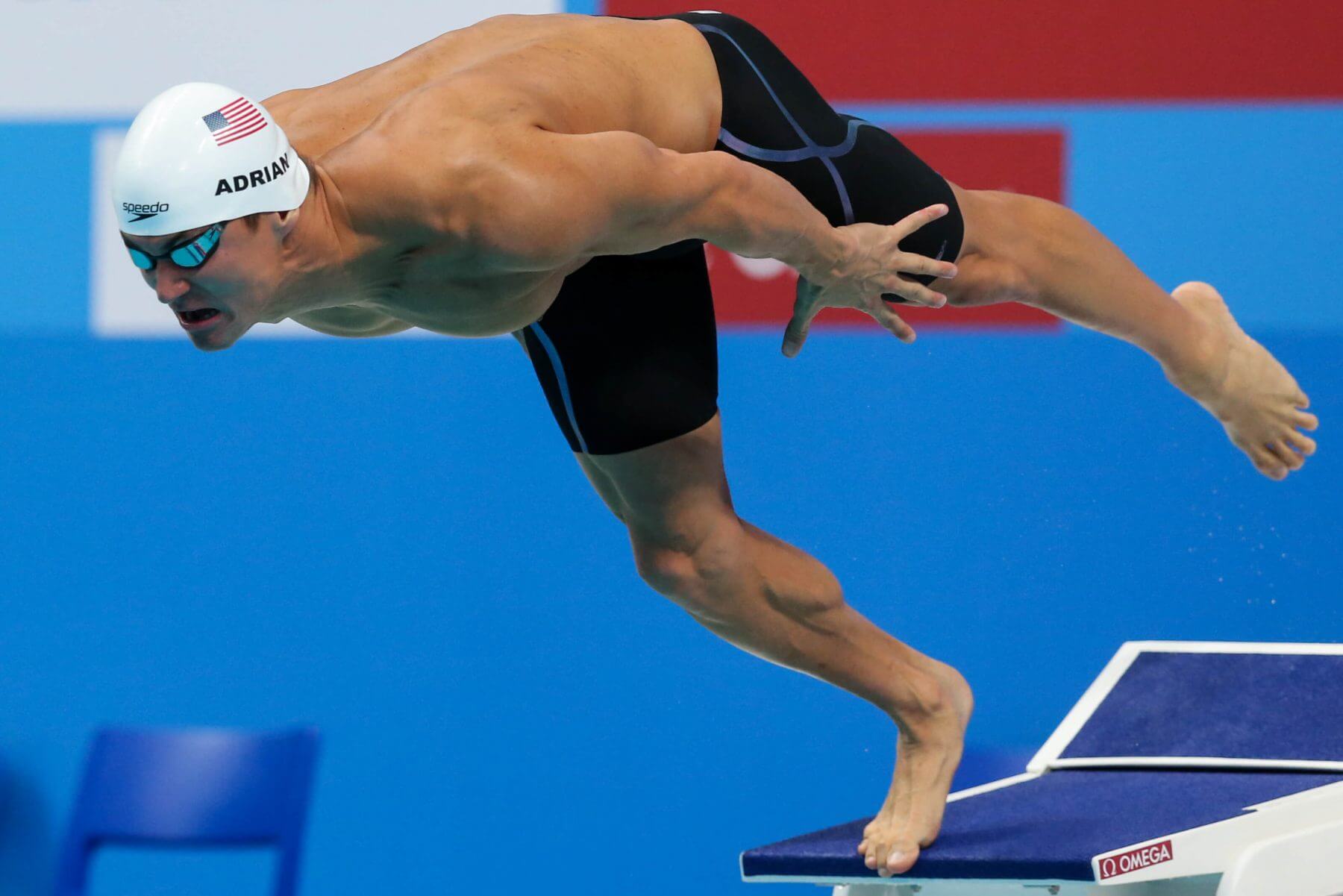
Photo Courtesy: SIPA USA
Adrian’s answer: not much. But just by holding regular workouts for the Cal men’s team preparing for the Pac-12 and NCAA Championships and for Durden’s sizable cadre of professionals, Adrian had a place he could go where things would seem normal—“even if they weren’t normal.”
Between the diagnosis and surgery, Adrian kept showing up at practice. Two weeks after having his first surgery, once the incision had healed up enough, Adrian went back to practice—not necessarily for his normal routine, but for some volume, 3000 or 4000 yards of swimming at a not-too-stressful pace to maintain fitness.
Adrian credits his physical condition to helping him recover quicker than doctors expected from his procedures, but that wasn’t the point of all the swimming while he still had medical obstacles to overcome. Swimming became his emotional medicine, helping keep Adrian calm and levelheaded.
“It was as predictable as day and nighttime,” he said. “I knew if I went to practice and when I went to practice, I would feel better doing that, and I would feel better for several hours after that. It was kind of an endorphin rush. It was absolutely very, very real for me and very, very helpful.”
Normal Life, Again
After successful surgery to remove his lymph nodes, Adrian’s treatment was finished. His scans were clean, so he started active surveillance—blood tests every two months and an MRI every three months for the foreseeable future. Now, regular life—and swimming—beckoned.
Full steam ahead right away? Not exactly, no, though Adrian pointed out that “after doing this for so long, day one when you get back in the water is full steam ahead in terms of working as hard as your body will let you work.” But Adrian’s body wasn’t quite ready to cooperate yet.
His weight was down under 215 pounds, compared to a normal training weight between 225 and 230—“lighter than I had been in probably 10 years.” Once he could finally eat a diet with a normal quantity of fat, Adrian tried to regain the muscle he had lost, but the required calorie surplus meant he added more body fat than desired.
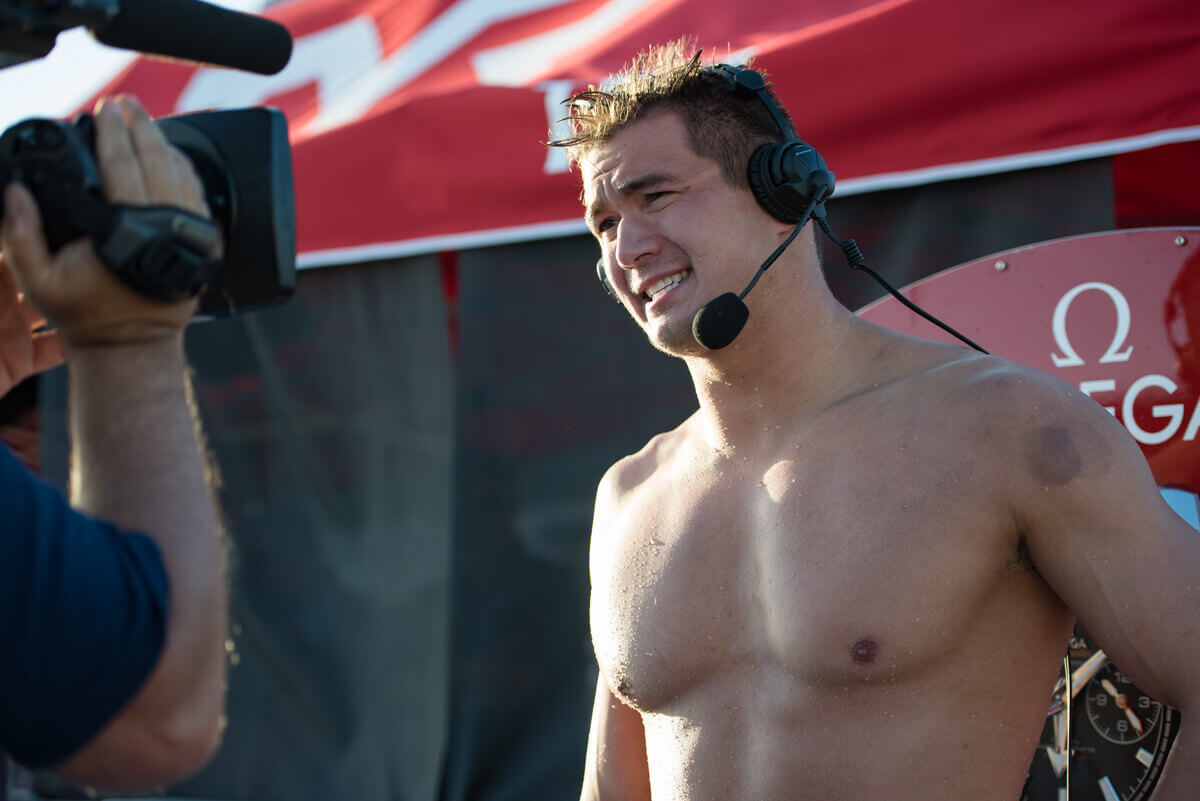
Photo Courtesy: Brooke Wright
Perhaps most annoying were the imbalances Adrian felt for weeks after surgery. While the right side of his body was operating mostly normally, he could not flex core muscles on his left side.
“You hunker down, you flex your abs, you look down, and they’re all flexed. They’re all firing at the same time,” Adrian said. “I would send those same signals from my brain to my abs to flex, and my left side would be super soft. They just wouldn’t go. I couldn’t figure out, ‘How can I make these stupid abs flex?’ They just wouldn’t do it.”
As if it were the start of a fall season, Adrian and Durden built the training progressively: Just afternoon practices in week one, adding a morning practice in week two, then ramping up the volume and adding in more quality work. Adrian still feels some imbalances, but he now trains without restrictions.
“I’m not worried about getting a hernia or causing other issues in my body now—which is a great feeling, because when you lose it, it really, really sucks,” he said.
Back on the Blocks
Last year before the cancer, Adrian qualified to race the 400 free relay for the U.S. at the World Championships in Gwangju, South Korea, and also to compete individually at the Pan American Games in Lima, Peru. The cancer threw those plans into question, but Adrian has every intention of making both trips.
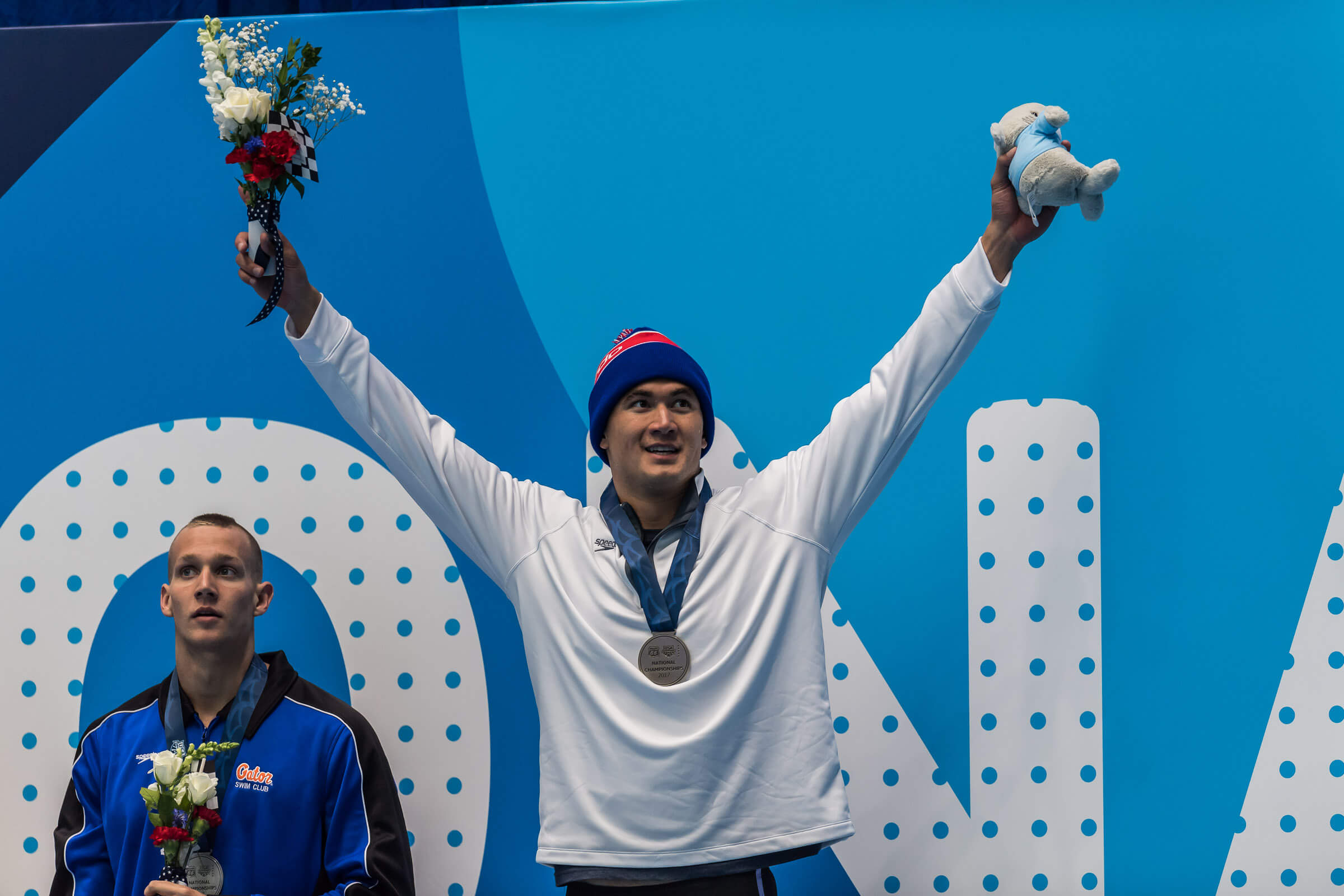
Nathan Adrian at U.S. Nationals in 2017 — Photo Courtesy: Peter H. Bick
That said, he’s realistic. Should his routine scan and blood draw scheduled between now and July come back with an issue, it’s back to square one. His next step would be chemotherapy. For the foreseeable future of active surveillance, that’s a reality that Adrian will live with.
Now, he’s ready to compete again for the first time since Winter Nationals in early December. That’s the second-longest racing layoff Adrian can remember taking, behind a seven-month break following his third Olympics in 2016.
“I remember very vividly how, after 2016, I took the longest break from competing I had taken, I don’t know, pretty much ever,” he said. “It was like, ‘I don’t know what this is going to be like.’ I remember very vividly, it was like, ‘Oh, I do have my process. I do have my own routines.’ But you get nervous. And you get nervous in the best way, that nervous energy telling you that you’re ready to go.”
At the upcoming TYR Pro Series in Bloomington, Ind., Adrian will return to a scene so normal for him—a 100 freestyle off the blocks in a racing suit against typical competition that will include past international relay teammates Blake Pieroni, and Zach Apple.
Normally, that’s a task so routine, so mundane. Now, after the health saga of the past five months, Adrian has no idea what it will feel like.
“Through a lot of this, a lot of things become a little bit more emotional—the idea that this was almost taken away,” Adrian said. “I promise you, I feel like I tried to do the best job that I could to appreciate every single day as I was living a very wonderful life as a professional swimmer, but now it means so much more.”




Awesome news
The swimming community and world LOVES to see this.
Great news… God bless
Such an inspiration!!! Go Nathan!!
Awesome!! ???
Go get em !
??
Good luck to you…
Awesome! ???
Love this guy, such a great swimmer. xx ??????